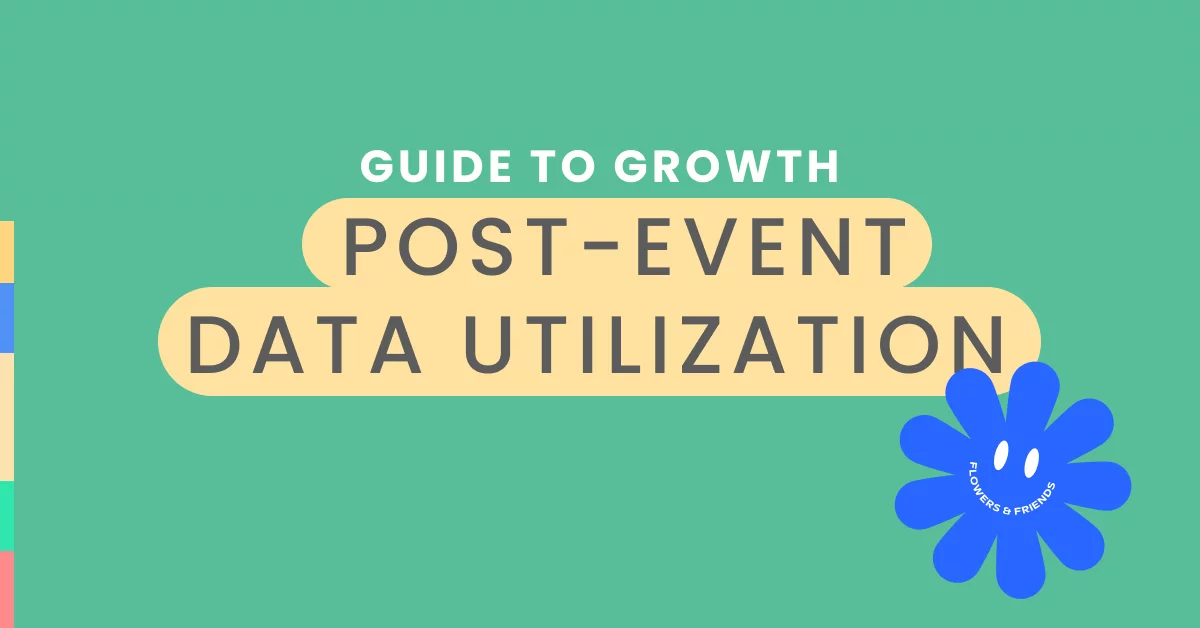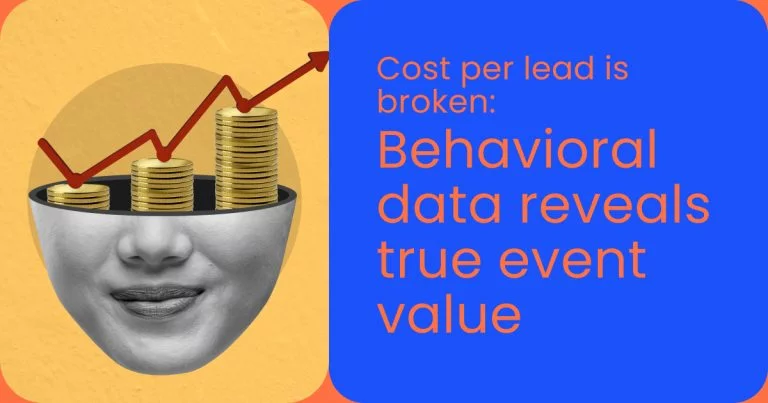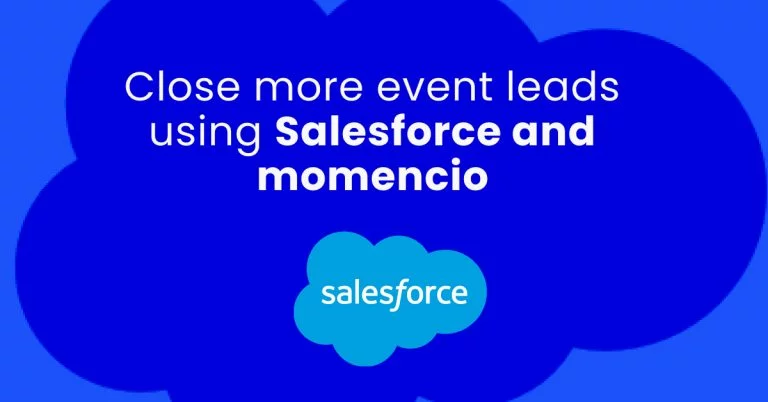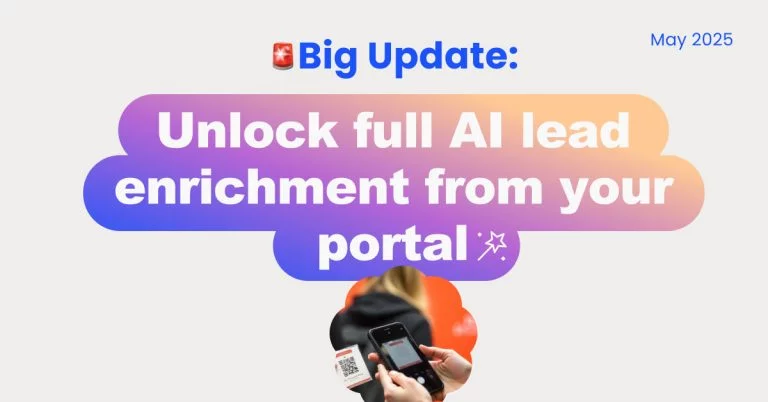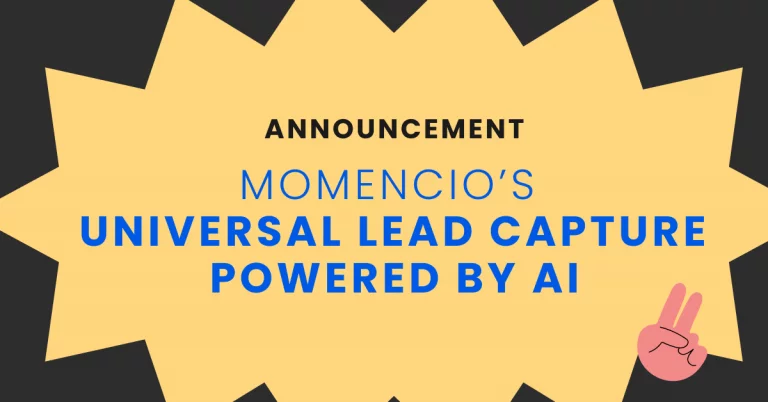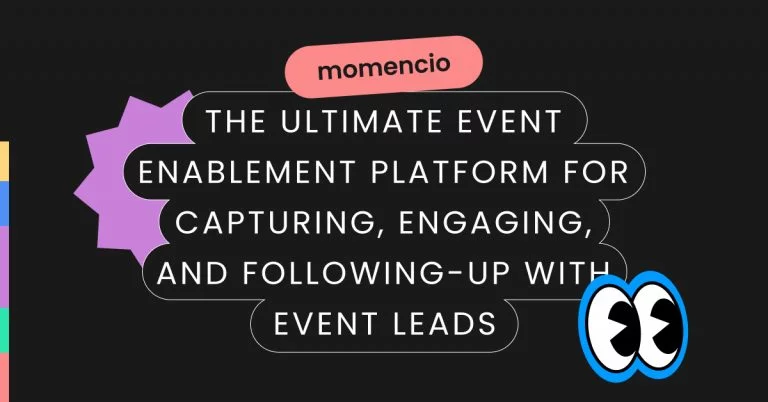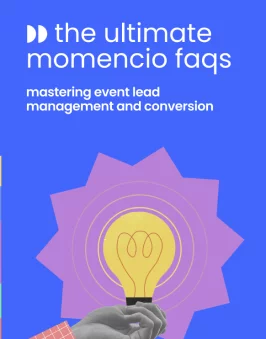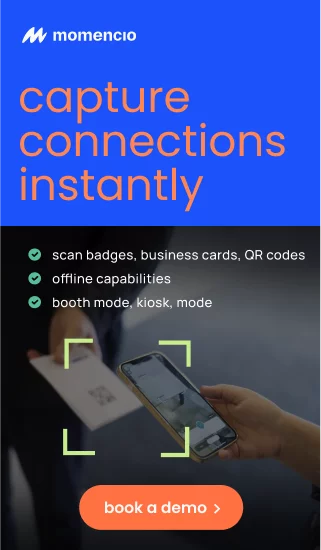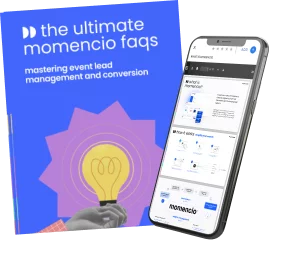The crux of a successful event doesn’t lie solely within the confines of its execution. Still, it extends far into the aftermath, where the gathered data holds the key to unlocking immense strategic value. For instance, a recent study indicated that events utilizing structured post-event data analysis observed a 20% increase in attendee retention for subsequent events. This introductory exploration into Post-Event Data Utilization will delve into its critical role in refining event planning and magnifying return on investment (ROI). By harnessing comprehensive post-event insights, organizers can pivot from generic strategies to personalized attendee experiences, thereby catalyzing event success.
TL;DR: Post-event data is a goldmine for improving future events. Learn how to analyze attendee behavior, engagement metrics, and lead data to optimize your follow-up strategy, refine event content, and drive better sales outcomes from your event-generated leads.
What does post-event data utilization mean?
Post-event data utilization is your secret weapon for turning a one-off event into a lasting success. It’s about taking every interaction, every attendee touchpoint, and every feedback form and transforming them into actionable strategies for future growth.
Think of it as building a roadmap from your event data. What sessions were packed? Which speakers brought the house down? Where did attendees disengage? By analyzing this information, you can pivot from guesswork to precision planning.
Post-event data utilization doesn’t just improve logistics; it elevates the entire attendee experience. It’s how you keep them coming back, boost ROI, and prove to stakeholders that every dollar spent was worth it.
Types of post-event data and how to use them
Post-event data comes in many forms, and each type holds valuable insights that can shape future event strategies. From understanding your attendees’ demographics to analyzing their engagement patterns, this data allows you to create more tailored, impactful events. Below is a quick guide to the main types of post-event data, examples of what to track, and how they can be put to use effectively.
Data type |
Example |
Use case |
| Attendee demographics | Job titles, industries | Tailor future event content and messaging |
| Session engagement | Attendance, polls, Q&A | Identify popular topics, sessions, and speakers |
| Lead behavior | Booth visits, downloads | Refine lead nurturing and prioritize follow-ups |
| Feedback data | Survey results, comments | Improve event logistics and attendee experiences |
By leveraging these different types of post-event data, event planners can move beyond one-size-fits-all approaches and develop more personalized, data-driven strategies. Each piece of information, from session engagement to attendee demographics, contributes to creating events that resonate with audiences, improve ROI, and foster long-term success.
What role does data play in post-event analysis?
Data is the engine driving event success. Without it, you’re flying blind. With it, you’re equipped to optimize every aspect of your event—from attendee engagement to ROI tracking.
Why data is everything in post-event analysis:
- It measures impact: Attendee engagement, session attendance, and lead quality aren’t just numbers—they’re proof of what worked.
- It personalizes experiences: Data helps you dig deep into what attendees want, letting you craft experiences that feel tailor-made.
- It shows ROI in black and white: Post-event data connects outcomes (like leads generated or deals closed) directly to your investment, giving you the tools to justify your budget.
- It fuels innovation: Data reveals trends and insights you can use to rethink formats, content, and strategies, keeping your events fresh and relevant.
By using data as your guide, you’re not just planning the next event—you’re building a legacy of impactful, data-driven experiences.
Why post-event data utilization is crucial
At the heart of every event lies a trove of data, each attendee interaction and feedback response carrying the potential to sculpt the future of event planning and execution. Leveraging post-event data is not just a reactive measure; it’s a proactive strategy for continuous improvement and growth. Here’s how pivotal post-event data is in informing future events and driving increased ROI.
Turning feedback into strategy
Post-event data utilization begins with the understanding that every piece of feedback is a directional sign toward improvement. Data gathered from post-event surveys, session evaluations, and social media interactions offer a candid look at what worked and what didn’t, providing invaluable insights into attendee preferences and expectations. By mining this data, event planners can shift from a generic event blueprint to a highly tailored approach that resonates with their audience.
Engagement metrics as a north star
Engagement metrics serve as the north star, guiding event planners in measuring the success of their sessions and the overall event. Metrics such as session attendance rates, app engagement levels, and interactive poll participation provide a quantitative measure of attendee involvement. This data not only benchmarks the current event’s success but also aids in fine-tuning the content and format of future events for maximum engagement.
Lead scoring and prioritization
Lead scoring models become more refined with the aid of post-event data. By analyzing attendee behavior, session participation, and engagement levels, event planners can score and prioritize leads more effectively, focusing their follow-up efforts on those with the highest likelihood of conversion. This targeted approach ensures a more efficient allocation of resources and a higher conversion rate.
Informing ROI calculation
Calculating the return on investment (ROI) of an event is complex, but post-event data simplifies this calculation. By tracking the cost against the leads generated, networking opportunities created, and deals closed as a direct result of the event, planners can present a clear picture of the event’s financial success. Furthermore, this data enables a more strategic approach to budget allocation for future events, ensuring funds are invested in high-return activities.
The blueprint for continuous improvement
Post-event data acts as a blueprint for continuous improvement. By methodically reviewing what the data reveals about every aspect of the event—from logistical hiccups to the most well-received speakers—planners can implement incremental changes that cumulatively enhance the attendee experience and operational efficiency over time.
Step-by-step guide to collecting and analyzing event data
Transforming raw event data into strategic gold requires a systematic approach. Here’s how to make the post-event chaos a source of clear direction for future success.
Step 1: Defining objectives and metrics
Before the event, pinpoint what you intend to track. Will it be lead engagement, session attendance, or networking effectiveness? Define clear metrics that align with these goals, such as conversion rates post-event or the number of interactions within a session.
Step 2: Data capture and collection
Implement tools for seamless data capture. From badge & business card scanning with tools like momencio to app analytics and social media engagement tracking, ensure you’re capturing data across all touchpoints. Use pre-event surveys to benchmark attendee expectations and post-event surveys for their feedback.
Step 3: Aggregating and organizing data
Gather your data into a centralized system. This may involve consolidating analytics from various platforms and aligning them with the attendee list and other CRM data to paint a complete picture.
Step 4: Analytical review
Dive into the data with a focus on your objectives. Tools and platforms that offer real-time lead scoring and analytics, such as momencio, can help you prioritize leads for follow-up. Examine session engagement levels, content downloads, and overall interaction rates.
Step 5: Actionable insights
Distill your analysis into actionable insights. What does the data suggest about your audience’s preferences? How did the engagement levels differ by session topic or time of day?
Step 6: Strategy adjustment
Use these insights to inform your strategy for future events. This might mean changing up the content, adjusting the schedule, adding more networking opportunities, or even revamping the event format.
Step 7: Reporting and communication
Create comprehensive reports that not only detail the successes and learnings from the event but also clearly communicate the ROI to stakeholders. These reports should guide your team’s strategy moving forward.
Step 8: Implement changes
Armed with a data-backed understanding of what drives attendee engagement and lead conversion, implement the necessary changes. Whether it’s personalized follow-up campaigns or reimagined event experiences, let the data lead the way to enhanced event ROI.
Personalizing attendee experience using post-event insights
Data collected from your latest event isn’t just numbers in a spreadsheet—it’s the key to unlocking a more personalized and impactful attendee experience for your next affair. Here’s a comprehensive approach to using post-event insights to tailor future events to the preferences and behaviors of your audience.
Understanding the audience
Begin with a demographic and psychographic analysis of your attendees. This involves scrutinizing the data to understand their job roles, industries, interests, and what they seek to gain from your event. Tools like momencio provide deep insights into attendees’ interactions, which can help you segment your audience more effectively.
Feedback analysis
Next, dive into the feedback. Post-event surveys, social media interactions, and session ratings offer a goldmine of information about what attendees liked and what could be improved. Analyze comments for patterns and pay special attention to any suggestions made by multiple attendees.
Engagement metrics
Look closely at engagement metrics. Which sessions had the highest attendance, and which networking events were most popular? Utilize engagement analytics from momencio to detect topics and formats that resonated the most, paving the way for future content planning.
Behavioral data
Examine behavioral data to understand how attendees interacted with various event elements. Did they download session materials, visit virtual booths, or engage in polls or Q&A sessions? This behavioral data can guide the design of more engaging content and interactive elements.
Tailoring content and format
Using these insights, adjust the content and format of your future events. If specific topics were hits, consider deep dives or advanced sessions. If networking was a highlight, allocate more time and resources to facilitate connections.
Personalized communication
Post-event data isn’t just for planning; it’s also for communication. Use insights to create personalized post-event communications, such as thank-you emails, content recaps, and invitations to future events that align with their interests.
Continuous learning and adaptation
Finally, ensure that the data insights are shared across teams to inform broader marketing and sales strategies. This will help continuously improve the attendee experience and drive event ROI.
Advanced techniques for post-event data analysis
Transforming raw event data into meaningful strategies requires advanced techniques and a systematic approach. The goal is to uncover the narrative the numbers are telling and use this to fine-tune future event planning for improved ROI and enhanced attendee experiences. Here’s a structured method to deep-dive into post-event analytics:
Utilizing predictive analytics
Predictive analytics involves using historical event data to forecast future outcomes. By applying machine learning algorithms, you can predict attendee behaviors, preferences, and the potential success of different event elements. Tools like momencio can provide predictive insights that guide decision-making for future events.
Semantic analysis of feedback
Attendee feedback, both qualitative and quantitative, is a goldmine. Use semantic analysis to interpret the sentiment behind feedback, categorizing it into themes and emotions. This process can reveal underlying opinions and trends that might not be apparent at first glance.
Network analysis for engagement patterns
Understanding how attendees interact with each other and your content can unveil the most influential nodes and connections in your event. Network analysis can map out these relationships, highlighting opportunities to foster better engagement and community building at subsequent events.
Conversion funnel analysis
Post-event data can help you visualize your conversion funnel, from initial engagement to the final sale. Analyzing drop-off rates at various stages enables you to pinpoint areas for improvement and develop targeted strategies to increase conversion rates.
Multi-event benchmarking
Compare data across multiple events to establish benchmarks and identify patterns over time. This longitudinal analysis can help understand the long-term effectiveness of your strategies and make informed decisions that continuously improve the event experience.
Integrating AI for deeper insights
Artificial intelligence can process vast amounts of data quickly, providing deeper insights into attendee behavior, content engagement, and more. AI-driven tools can help you understand complex data sets and reveal correlations that inform more nuanced event strategies.
Leveraging technology: AI and analytics in post-event review
AI and analytics play a pivotal role in post-event reviews, offering deep insights and driving strategic improvements for future events. Here’s how leveraging technology can transform your post-event analysis:
AI-driven data interpretation
Artificial Intelligence (AI) can process large volumes of data quickly, identifying patterns and trends that might need to be noticed by human analysis. Tools like momencio utilize AI to give event organizers a comprehensive understanding of their event’s performance.
Real-time analytics for immediate insights
The ability to access analytics in real time can significantly improve the speed at which you can respond to attendee behaviors. Real-time insights allow you to adapt your ongoing and future event strategies to meet attendee needs and preferences better. This is the power of real-time event analytics!
Enhanced lead scoring
AI algorithms can score leads more effectively by analyzing engagement metrics and predicting future behaviors. This ensures that the follow-up process is prioritized and more likely to result in conversions.
Predictive analytics for future planning
Predictive analytics can forecast future attendee behaviors based on historical data, helping you to better cater to your audience’s interests and improve engagement for subsequent events.
Personalization at scale
AI and analytics enable personalization at scale, crafting unique attendee experiences based on individual behaviors and preferences noted during the event.
Sentiment analysis
AI-powered sentiment analysis tools can interpret attendee feedback from surveys, social media, and other channels to gauge the overall sentiment toward your event, providing valuable insights into areas that require improvement.
Network and relationship analysis
Analyzing the networks and connections formed at your event can inform future networking opportunities and community-building efforts, contributing to a stronger event community.
Automation of repetitive tasks
AI can automate repetitive tasks such as data entry and report generation, allowing event teams to focus on more strategic tasks that require human insight.
Leveraging AI and analytics technology in post-event reviews is not just about understanding what happened but also about predicting and shaping what could happen in the future. The intelligence gathered through these means becomes the foundation for a continuously improving event strategy, ensuring each event is better than the last.
Conclusion: synthesizing data for continuous improvement
The aftermath of an event is a treasure trove of data, ripe for analysis and rich with insights that can steer future strategies toward success. Synthesizing post-event data is an art and a science that involves a meticulous approach to dissecting every detail—from attendance rates, engagement metrics, and feedback forms to session popularity. The critical task is to look beyond the numbers and seek the stories they tell.
For continuous improvement, every dataset should lead to a question or a hypothesis. Why did specific sessions have higher attendance? What was it about the speaker or topic that resonated with the audience? These answers then feed into a continuous loop of learning, planning, and execution. This data-centric approach does not merely suggest incremental changes but can spark revolutionary ideas for future events.
Interesting facts from research
- Post-event analysis can lead to a 20% increase in attendee satisfaction if the data is used to tailor future events.
- Events that utilize lead capture and real-time analytics software see, on average, a 15% higher return on investment.
- Surveys show that 70% of event planners believe data analytics is the most critical skill in improving their events in the coming years.
Implementing your data-driven event strategy
The journey from data collection to execution is complex, but it’s a path that leads to enriched experiences for both the host and the attendee. Your next event’s success hinges on how well you can implement a data-driven strategy that you’ve synthesized from past learnings. Start by laying down a concrete plan for your next event, with checkpoints that allow you to collect, analyze, and act on data in real time.
Engage with platforms that prioritize data analytics and lead management, like momencio, and consider booking a demo to see how their solutions can fit into your improved event strategy.
FAQs
- How can post-event data improve future event planning?
- Post-event data provides insights into what worked well and what didn’t, allowing event planners to tailor their strategies to enhance attendee satisfaction, engagement levels, and overall ROI for future events.
- What are the best practices for collecting post-event data?
- Effective practices include timely surveys, tracking digital engagement metrics, leveraging event apps for feedback, and employing lead retrieval systems to understand attendee behavior.
- How can I use post-event data to personalize attendee experiences?
- By analyzing feedback and engagement patterns, event planners can segment their audience and customize future content, activities, and communications to match attendee preferences and interests better.
- What role does technology play in post-event data analysis?
- Advanced analytics platforms and AI can swiftly process large volumes of data, delivering actionable insights and predictive models that help shape more successful event strategies.
- Can post-event data help calculate an accurate event ROI?
- Absolutely. By evaluating various metrics like lead conversion rates, attendee engagement, and overall costs against revenues, planners can quantify the success of an event and make informed budgeting decisions for future events.
